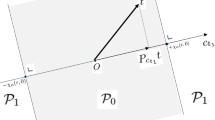Abstract
A statistical learning model is considered within the framework of the theory of uniform convergence of frequencies of errors in the case where the convergence is violated as a result of increasing the informativeness of training examples. Drawbacks of nonconstructive refinements of Vapnik-Chervonenkis estimates based on an assumption on the distribution law of violations are shown. A new approach to obtaining constructive estimates for mass data sets is proposed.
Similar content being viewed by others
REFERENCES
J. Way and E. A. Smith, “The evolution of synthetic aperture radar systems and their progression to the EOS SAR,” IEEE Trans. Geosci. and Remote Sens., 29, No. 6, 962-985 (1991).
U. Fayad, S. G. Djorgovski, and N. Weir, “Automating the Analysis and Cataloging of Sky Surveys,” in: U.M. Fayad, et al. (eds.), Advances in Knowledge Discovery and Data Mining, AAAI Press, Cambridge (1996), pp. 471-494.
C. J. Matheus, G. Piatetsky-Shapiro, and D. MsNeill, “Selecting and reporting what is interesting: The kefir application to healthcare data,” in: U. M. Fayad, et al. (eds.), Advances in Knowledge Discovery and Data Mining, AAAI Press, Cambridge (1996), pp. 495-516.
D. Conklin, S. Fortier, and J. Glasgow, “Knowledge Discovery in Molecular Databases,” IEEE Trans. Knowledge and Data Eng., 5, No. 6, 985-987 (1993).
M. C. Burl, U. Fayad, P. Perona, et al., “Automating the hunt for volcanoes on Venus,” in: Proc. of Computer Vision and Pattern Recognition Conf. (CVPR-94), IEEE CS Press, Piscataway (NJ) (1994), pp. 302-308.
P. Stolorz and C. Dean, “Quakefinder: A scalable data mining system for detecting earthquakes from space,” in: Proc. 2nd Intern. Conf. on Knowledge Discovery and Data Mining, AAAI Press, Cambridge (1996), pp. 75-87.
Y. Sakakibara, M. Brown, R. Hughey, et al., “Stochastic context-free grammars for t RNA modeling,” Nucleic Acids Research, No. 22, 5112-5120 (1994).
J. Major, “Selecting among rules induced from a hurricane database,” in: Proc. of KDD-94: AAAI-94 Workshop on Knowledge Discovery in Databases (AAAI Techn. Rep. WS-94-03), AAAI Press, Melno Park (CA) (1993), pp. 28-44.
P. Stolorz, et al., “Data analysis and knowledge discovery in geophysical databases,” in: Concurrent Supercomputing Consortium Annual Report, California Inst. Technology (1994), pp. 12-14.
V. M. Glushkov, Principles of Paperless Informatics [in Russian], Nauka, Moscow (1982).
V. N. Vapnik, Restoration of Dependences from Empirical Data [in Russian], Nauka, Moscow (1979).
D. P. Helmbold and P. M. Long, “Tracking drifting concepts by minimizing disagreements,” Machine Learning, No. 14, 27-45 (1994).
P. Bartlett, “Learning with slowly changing distribution,” in: Proc. Workshop on Computational Learning Theory, Morgan Kauffman Publ., San Mateo (CA) (1992), pp. 243-252.
R. D. Barve and P. M. Long, “On the complexity of learning from drifting distributions,” in: Proc. Workshop on Computational Learning Theory, Morgan Kauffman Publ., San Mateo (CA) (1996), pp. 132-142.
P. Bartlett, S. Ben-David, and S. Kulkarni, “Learning changing concepts by exploiting the structure of change,” in: Proc. Workshop on Computational Learning Theory, Morgan Kauffman Publ., San Mateo (CA) (1996), pp. 143-155.
A. Kuh, T. Petsche, and R. Rivest, “Learning time-varying concepts,” in: Advances in Neural Information Processing Systems, Morgan Kauffman Publ., San Mateo (CA) (1991), pp. 183-189.
T. Mitchell, R. Caruana, D. Freitag, et al., “Experience with a learning personal assistant,” CACM., No. 37, 81-91 (1994).
G. Widmer and M. Kubat, “Learning in the presence of concept drift and hidden contexts,” Machine Learning, No. 23, 69-101 (1996).
R. Klinkenberg and I. Renz, “Adaptive information filtering: Learning in the presence of concept drifts,” in: Workshop Notes of the ICML-98 Workshop on Learning for Text Categorization, AAAI Press, Melno Park (CA) (1998), pp. 33-40.
C. Taylor, G. Nakhaeizadeh, and C. Lanquillon, “Structural change and classification,” in: Workshop Notes of the ECML-97 Workshop on Dynamically Changing Domains: Theory Revision and Context Dependence Issues, AAAI Press, New York (1997), pp. 67-78.
A. V. Kharchenko, “Generalization of some estimates of statistical learning theory to mass data sets,” Upr. Sist. Mash., No. 1, 59-64 (2000).
J. Rissanen, “Stochastic complexity in statistical inquiry,” World Scientific. Ser. in Computer Sci., 15 (1989).
D. Haussle, M. Kearns, and R. Shapire, “Bounds on the sample complexity of Bayesian learning using information theory and the VC dimension,” Machine Learning, 14(1), 83-113 (1992).
D. MacKay, “Information-based objective functions for active data selection,” Neural Computation, No. 4 (4), 590-604 (1990).
I. Guyon, N. Matic, and V. Vapnik, “Discovering informative patterns and data cleaning,” in: U. M. Fayad, et al. (eds.), Advances in Knowledge Discovery and Data Mining, AAAI Press, Cambridge (1996), pp. 181-203.
I. N. Kovalenko and B. V. Gnedenko, Probability Theory [in Russian], Vyshcha Shkola, Kiev (1990).
V. N. Vapnik, Statistical Learning Theory, Wiley, New York (1998).
Author information
Authors and Affiliations
Rights and permissions
About this article
Cite this article
Perevozchikova, O.L., Tul'chinskii, V.G. & Kharchenko, A.V. Distinctive Features of Minimization of a Risk Functional in Mass Data Sets. Cybernetics and Systems Analysis 39, 501–508 (2003). https://doi.org/10.1023/B:CASA.0000003500.91054.5b
Issue Date:
DOI: https://doi.org/10.1023/B:CASA.0000003500.91054.5b




